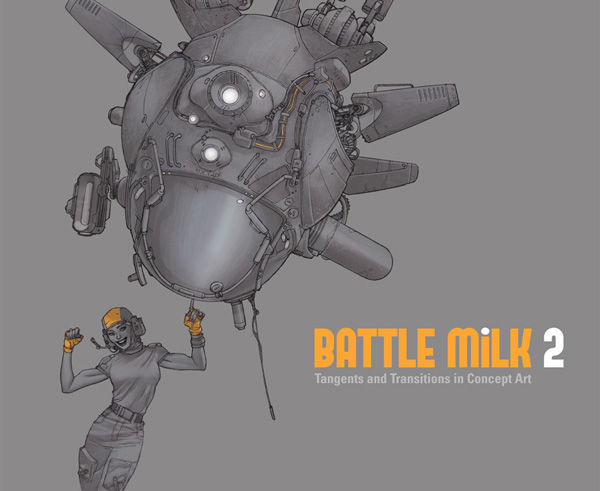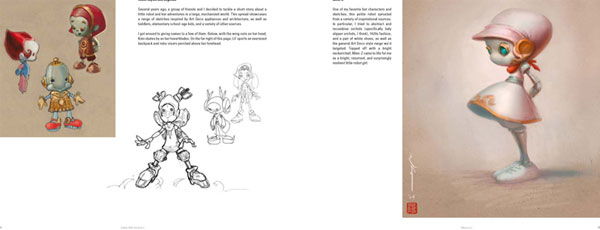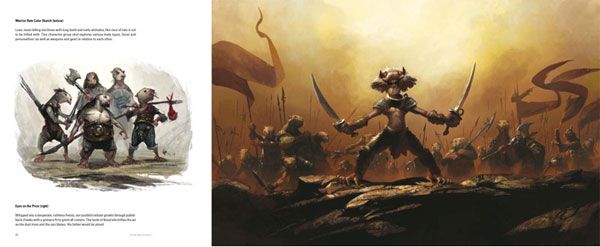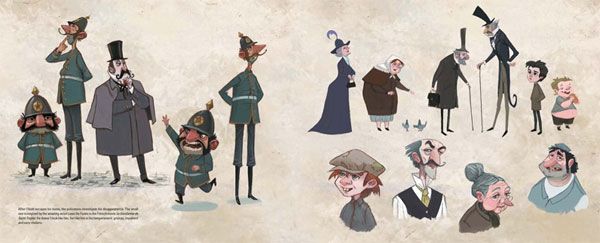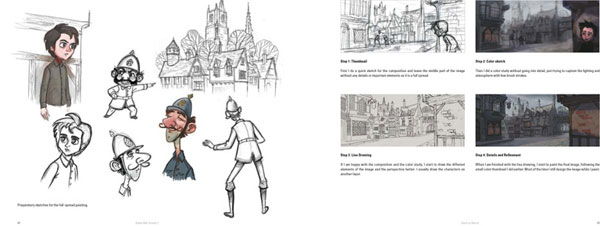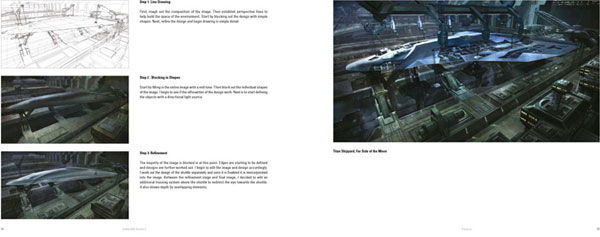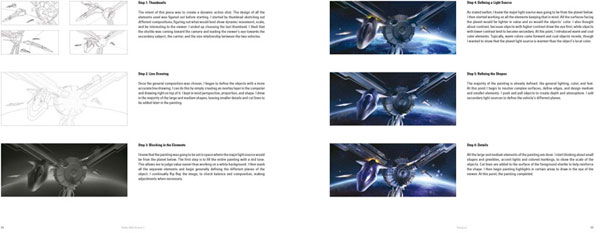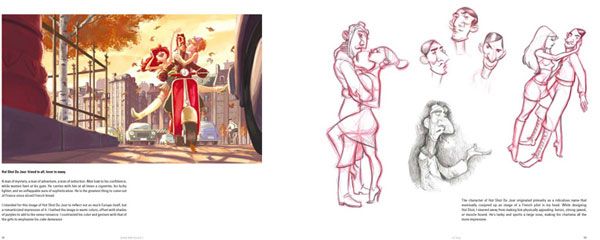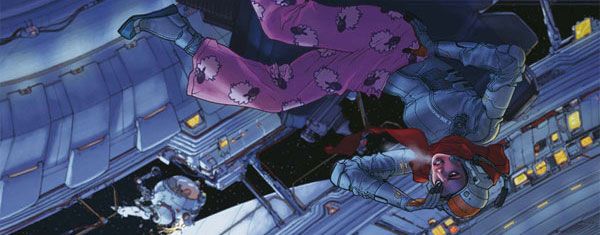Battle Milk 2 by Christina Apeles
Article by Martin Gibson – @embody3d @martingibson – 28.03.2011
Battle Milk 2 – Tangents and Transitions in Concept Art by Christina Apeles and published by Design Studio unfortunately isn’t about epic battles nor is it about the creamy delights of milk. Battle Milk 2 is in fact all about the interesting art of visual story telling. Even the author admits the name Battle Milk is a little bit of shenanigans.
The name was a tangent; a misinterpretation of a less ridiculous suggestion. As little sense as it made then, it makes perfect sense now. The title reflects our varied personalities and has now come to represent our very artistic diversity.
It’s best to think of these visual storytellers as those artists who generate comic strips, movie storyboards and short stories. Artists when equipped with just one canvas a variety of paints and mixed media can layout the tone and feel of a whole artistic piece and inspire the directors, actors, and writers around them.
Battle Milk 2 is a collaboration of six of the finest international visual storytellers alive today who once worked with one another on Star Wars: The Clone Wars. Each artist has a unique philosophy and style which adds to the fascination of the fantasy and sci-fi characters and scenery. The 120 pages of full-colour artist portfolios are beautifully illustrated and superbly presented. The subject matter like their techniques are diverse from innocent cutely pink characters to killer indestructible robots. Artists techniques range from the traditional to the digital with pen sketches and paints to miniature photography to complex layering using digital rendering as these beautifully realised worlds become real and immersive.
What adds to appreciation of each design is that you can really empathise with the artists who just loved and nurtured each on these canvases as they unravelled. Some pieces are left as quick doodle sketches whereas others are perfectly resolved giving a real insight into the development stages that go into creating such work. Underneath each piece is a recount on the influences, inspiration, goals and artistic techniques which are communicated in such a personal and conversational manner which builds a real intimacy between the artist and reader.
Wayne Lo
Wayne Lo has great international experience after working and training in both America and China. Wayne Lo has worked on many character designs from children’s books with environments that resemble Australian billabongs to Playstation 3 action titles. Wayne Lo uses shadow and lighting to juxtapose different elements on the canvas. Shadows are often used to add mystery and uncertainty to his landscapes to great effect. But then there’s another side of Wayne Lo which focuses on watercolour and hand sketched animé-like characters which proves the great diversity of his portfolio.
David Le Merrer
David Le Merrer was born and raised in Paris but later moved to the United States, and like Wayne Lo has worked on many video games, although his work seems to favour short story books. David Le Merrer has a really dark side which would be excellently suited to a Tim Burton movie. There is a lot of artistic expression shown through his sketches which are highly desaturated. His backgrounds are simple like his characters but they speak volumes in communicating a scene. There is also a great sense of history and realism shown in his work with many period pieces featured. Le Merrer has mastered his characters facial expressions with subtle details that add such intrigue and fun to each one of his scenarios.
Thang Le
Thang Lee was born in Southern California and was heavily influenced by comic books, animated and sci-fi movies and playing video games. Thang Lee unleashes his imagination with some spectacular sci-fi scenes of distant planets which are inhabited by aliens and robotic life forms. There is great detail and intricacy in Lee’s work which really overwhelms the observer. Lee uses strong contrast to show dark, but lively industrial and mechanical environments. Lee’s work is also probably most in tune with the industrial design practitioner with even some futuristic vehicle designs. You can tell by his style, perspective and line work of his industrial design origins at the Art Center College of Design where he majored in transportation design.
Kilian Plunkett
Kilian Plunkett from Dublin Ireland changes the atmosphere of Battle Milk 2 completely with animations resembling the likes of Scooby Doo, Hey Arnold! and the Jetsons. Plunkett’s work is heavily influenced by comics with his characters having strong bold outlines. His portfolio is just filled with colour; influenced by 60’s and 70’s influences his work features many retro forms that are re-invented in a modern grungy style.
Le Tang
Le Tang’s short but prosperous career thus far has been cenetered around animation and a story illustrations for 3D television shows. Like Plunkett, Tang has a slightly modern twist to his characters. Tang isn’t scared to experiment with some very bold primary colours to bring his characters and scenes to life. Tang uses computers to generate many of the general shapes quickly and this is evident in the very Web 2.0 shading, highlights and gradients utilised.
Jackson Sze
Sze has worked in advertising, video games, television, and film and studied at the Art Center College of Design. Jackson Sze probably has the most unique style out of all the artists. Sze meshes the boundaries between traditional Chinese art, modernism and fantasy. He works mostly with paints and uses unique dabble effects to create ambiguous and free-flowing scenes that just look amazing. Sze is able to capture the momentum of water running down a cliff side, the reflections and ambience of sun dimming behind hillsides and clouds that weave in and out of mountain tops like dodgem cars.
Typically Embody 3D wouldn’t review such an artistic title but I believe the subject matter of entertainment and sci-fi certainly has some niche or even broader appeal to us industrial designers. On second glance the subject matter and briefs of Battle Milk 2 actually place it completely in the middle of design and art. These works aren’t meant to be hidden in art galleries observed by the lucky few, but rather they have been developed and designed for commercial application. Yet still the work stays true to artistic values of freedom of expression and interpretative briefs, it’s a really exciting cross-road. Thang Lee’s creative amalgamation of traditional industrial design techniques and the presentation and mixed media of animated shows could have profound influence on working industrial designers. Even if the book may not be applicable to your own entertainment and educational desires I am sure you know someone who would really treasure Battle Milk 2 as part of a commercialised art collection. Battle Milk 2 is a really fun title suitable for all ages and tastes!
[rating:4]


